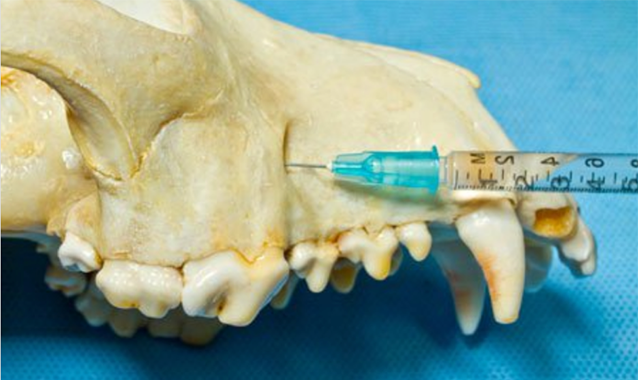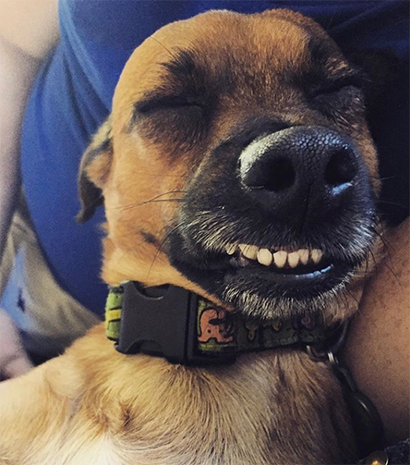Veterinary dentistry barks up the right tree
Humans aren’t the only ones suffering from dental disease. Dogs need proper dental care to prevent caries, periodontal disease, fractured teeth and more.

The first time I laid eyes on him, I was speechless. He had dark, piercing eyes, his hair glowed in the afternoon Arizona sun, and his skin was freshly shaven from the neuter he had earlier that day. No, I’m not talking about my boyfriend, but rather the first time I met our foster dog.
Days prior, through tears and pleading, I had convinced my boyfriend to save a dog from being euthanized at Maricopa County’s animal shelter for aggression. Quite frankly, there was something about this dog that I was drawn to, and knowing he was scheduled to be euthanized hurt my heart to no end. So here I was: picking up a dog at the county pound whom I knew nothing about, prepared to bring him home to Darby, our pug-beagle mix who had been the center of our world for as long as I could remember.
Spoiler alert: the moment we brought him home, we named him (Baxter), we bought him a collar with our phone numbers on it, and he was sleeping in our bed with us in no time. Baxter’s story is a unique one. From transient stray dog to terrified mutt at the pound to beloved mama’s boy, he has lived a “from rags to riches” life. When people come over to the house, I always ask them to identify which dog they think was scheduled to be euthanized for aggression. They look down at Baxter, who’s laying on his back and begging for belly rubs, and unanimously people agree there’s NO way Baxter was the “aggressive” dog. Nevertheless, dogs everyday are (in my opinion, unnecessarily) euthanized at county facilities.
More from the author: 5 ways to fall back in love with dentistry
Disclaimer: the individuals who work in county animal shelters are true heroes. They work alongside incredibly selfless and caring volunteers to tirelessly support homeless animals in finding their “FURever” homes. Their greatest challenge is there simply aren’t enough resources available to help every animal.
I was intrigued by Baxter’s story and wanted to learn more about how I could help. My stomach sunk as I learned that countless dogs and cats are euthanized daily due to dental disease that the shelter simply doesn’t have funding to treat. This dental disease ranges from caries and periodontal disease to abscesses of the periodontium and fractured teeth.
I knew I needed to be part of the change I wished to see for animals who were suffering in pain and couldn’t otherwise communicate this pain. In honor of Baxter’s incredible journey, I took a journey of my own to educate myself on canine dental disease and understanding how I can help. The following is a collection of unique facts I learned while attending the Veterinary Dental Forum in Phoenix, Arizona, in November 2018 with regards to canine dental disease. I hope you enjoy.

Dogs suffer from dental disease too
It’s estimated that almost 80 percent of dogs have some form of dental disease, whether it’s periodontal disease, dental caries, or abscesses of the dentition.
While dental decay is a major concern in humans throughout our lives, the greatest concerns in the canine dentition are periodontal diseases and fractured teeth.
As is common in both humans and canines, dental disease is typically borne of accumulation of dental biofilm. As dental biofilm accumulates and hardens to the tooth structure, it makes it difficult to control this disease process with a typical toothbrush and beef-flavored toothpaste. While I’ve certainly attempted to floss sweet Darby’s teeth, he prefers chewing on special chew toys and treats that are specifically designed to reduce the amount of plaque biofilm on his teeth. There are also water additives that are available that have been proven to reduce plaque accumulation and improve halitosis in dogs.
Trending article: How to eliminate dental patient phobias
The American Veterinary Dental College warns against giving dogs hard objects such as ice, nylon chews and even antlers, as this can increase the risk of tooth fracture. In addition, many pet owners have a grave concern over delivering systemic anesthesia for dental procedures. The speakers of the Veterinary Dental Forum advised that the systemic sequelae of dental disease is far more concerning than the stress of being anesthetized for dental surgery.
Plus, not all dogs experience the same level of diease.
We know the all-too-common scenario: “My husband never flosses and he has perfect teeth! How come I have so many cavities even though I brush and floss all the time?"
In dentistry, we’re beginning to understand the oral microbiome and the unique characteristics that individual patients present with. These characteristics may mean that their salivary biomarkers, oral pH, diet, genetics, oral anatomy, occlusion, or any other unique aspect about their oral microflora predispose some patients for disease over others.
The same is true of various breeds of canines.
Of note: dogs with smaller jaws and subsequently smaller teeth are often at a greater risk for periodontal disease and future dental extractions. This means my chihuahua-dachshund mix, Huey, needs extra careful attention when it comes to managing his dental disease. Baxter, my pit bull-pug mix, however, has a jaw to accommodate all of his teeth, perpetually pleasant breath (for a dog, that is) and doesn’t accumulate biofilm the same way.
Based on their risk assessment, Huey receives more frequent cleanings and dental chews daily. Baxter also gets dental chews simply because he’s handsome and a mama’s boy who gets whatever he wants, but he doesn’t require dental cleanings with the same frequency that Huey does.
Image provided by American Veterinary Dental College.

The injections are the same!
I was completely blown away to learn that the dental injections performed on canines are the same injections as performed on humans! They perform an inferior alveolar nerve block for mandibular anesthesia, and veterinarians deliver maxillary infiltrations or the infraorbital nerve block for maxillary anesthesia.
Related reading: 5 injection techniques you need to master
In reflection, I recognize that dog anatomy is incredibly similar to that of other mammals, and seeing as we name the injections after the nerve it anesthetizes, it makes sense. Nevertheless, I smirked in picturing the technique in getting Darby to open wide enough for an effective inferior alveolar nerve block. Like most pug-beagle mixes, he’s a bit of a drama queen, and this isn’t something I’d attempt while he was awake. Although, some would argue that perhaps Darby is better behaved than some of our patients…

If you want to help
I speak with countless dental professionals who are incredibly motivated and truly wish to utilize their incredible skills in the veterinary dental space.
First and foremost, shelters always need volunteers who are willing to spend time with their animals, particularly in programs to walk or socialize them, or even around events such as the Fourth of July when fireworks can make shelter dogs anxious. Shelters always appreciate donations of blankets and towels, dog food, dog crates, crate pads, collars, surgical neck cones and any other miscellaneous resources they find available. Finally, financial donations provide significant support in ensuring animals who require advanced medical or dental care receive that care.
More from the author: Are you suffering from burnout?
Should you wish to use your dental hygiene skills to support this cause, my first piece of advice is noting that every state has its own unique regulations regarding who may perform what procedures on animals. Of note: most states conclude that the owner of the animal may perform basic procedures such as delivering vaccinations and performing dental prophylaxis without anesthesia.
Darby looks forward to his full-mouth debridement procedure every three months and knows that the tell-tale sharpening noise means he’ll soon be enveloped in a towel (a la puppy burrito style) and receive periodontal scaling in between verbal “Who’s a good boy?” and “Who’s getting a McTreat after this?!” love. According to many states, animals in a county shelter situation are owned by the shelter, and as such, the shelter has the autonomy to decide who performs dental procedures on shelter animals.
In many other states, dental hygienists are permitted to perform dental prophylaxis procedures under the supervision of a veterinarian. I encourage you to identify the legal parameters within your state for additional guidance. If you live in Arizona, stay tuned for how we’ll join forces and make a dramatic impact on the lives of homeless animals throughout the state.

Conclusion
Huey, a chihuahua-dachshund mix showing his glorious lower anteriors.

To the world, Baxter may be one dog, but to me, he's my world. Every day I learn countless lessons from him, whether it's about unconditional love or the simple joys of a gorgeous day on the patio with a glass of wine. My sweet Baxter boy has enriched my world in so many ways and his story continues to inspire me.
Trending article: Are you a victim of ageism?
Should you feel compelled to be part of the change you wish to see for homeless animals like Baxter, I implore you to consider reaching out to your local animal shelter. They're always looking for volunteers, donations and resources.
Also, whether your dog is 6 years old or 11 years old (get it, because canines...), I encourage you to ensure you're bringing your fur baby in for annual dental examinations, radiographs and periodontal therapies to reduce his or her risk of dental and systemic disease.